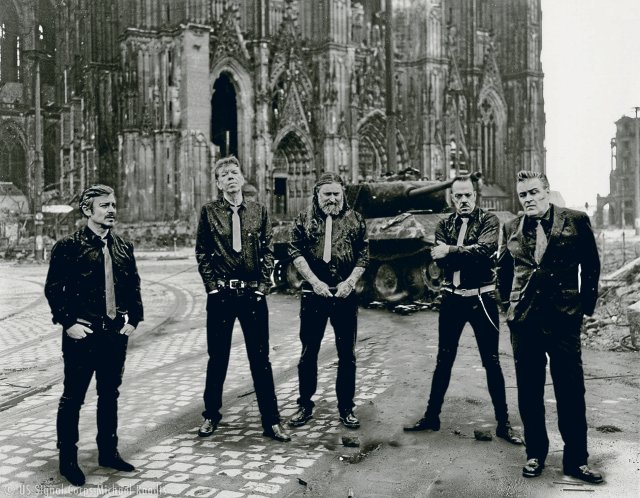Now less playful: The friends with singer Ray van Zeschau (1st from right)
Photo: US Signal Corps/Michael Raadts
Telling the story of the band Friends of the Italian Opera is no easy task. If you go looking for clues in the vastness of the virtual network, after a short research you end up in a thicket of stories, myths, stories, traditions – and a handful of facts.
One thing is certain: the band was founded in 1988 in the context of the Dresden State Theater – which was considered particularly progressive and subversive across the country at the time. After the fall of the Berlin Wall, FdiO, the common abbreviation, was for many the most innovative avant-garde band in the so-called new countries – including and especially in the west of the republic. The characteristic mix of rocky shanty vibes, profound post-punk riffs, homoerotic appearance, sophisticated brass arrangements and singer Ray van Zeschau’s sometimes psychotic-seeming screams of hell had never been heard in this style and intensity.
“Our artistic approach back then was to put everything through the meat grinder that wasn’t ready by three,” says van Zeschau, looking back. This distinguished them from the majority of the other bands in the independent scene at the time, which often tended towards latent humorlessness, such as the Hamburg School that was emerging at the time, whose artistic outpourings van Zeschau, looking back, characterizes as “moody sentimental stuff”.
nd.Kompakt – our daily newsletter

Our daily newsletter nd.Compact brings order to the news madness. Every day you will receive an overview of the most exciting stories from the world Editorial team. Get your free subscription here.
He was all the more surprised when Alfred Hilsberg contacted the band in the early 1990s. The founder of the two legendary indie labels ZickZack and Whats So Funny About came across the band through their debut album “Um Thron und Liebe”, released in 1991. Now he wanted to take a closer look at the band – and booked them for a concert in the Hamburg market hall. Ray van Zeschau still remembers the performance well: »We brought all the technology with us to Hamburg, but when we set it up it no longer worked. We were on the verge of demolition. Shortly before we reached the tipping point, it finally worked. And so we slammed all of our pent-up aggression off the stage one-on-one during the concert.«
Like the audience, Hilsberg was completely enthusiastic and wanted to sign the band immediately – but that never happened. At the end of 1992, after a final performance in northern Italy, the band broke up due to increasing internal tensions. Van Zeschau left the urban cultural life of Dresden and lived in seclusion as a cowboy in the country for a few years.
It wasn’t until 2009 that the band returned to the stage as part of the Leipzig festival “YOU DIDN’T WANT IT ANY OTHER”, a gathering of the former underground avant-garde of the late GDR. And so the project picked up speed again after almost 20 years – albeit with a completely new cast. Roger Baptist, the keyboard player of the early years, was running out of time as he had started a solo career as a shanty-like bodybuilder bard under the stage name Rummelsnuff. Contact with other original members had long since been broken off. And so van Zeschau has been the only remaining original member of the Friends of the Italian Opera ever since.
After the work “Via Dolorosa”, released in 2018, “Kassandras Complex”, only the fourth album in the band’s history, recently followed. Many core elements of the band’s early phase are still clearly recognizable: van Zeschau’s theatrical singing, for example, which sometimes reveals his unrecognized potential as an opera singer. The satirical humor with which contemporary developments are viewed and dissected has also remained.
But some things sound very different today than they did back then: the band is now less playful than in the early days, but much more straightforward and musically a lot harder and more brutal. The song “1989,” for example, literally cuts the top of your head off with its fast metal riffing. The piece is not new at all, but was written in the early 90s and was first found on the album “Edle Einfalt Stille Greatness”, which was published posthumously by Hilsberg in 1996. The original seems downright cute, almost foolish, in comparison today.
The clearest change, however, has taken place on the lyrical level: unlike in the early 90s, the song lyrics are now predominantly in German. In the past, this would have seemed strange to him, says van Zeschau. That’s why he mostly had the texts translated into English.
And yet, in addition to “1989,” there are other English titles on “Kassandra’s Complex,” all of which come from the band’s early phase: such as “She Kill The Laugh,” which the band originally wrote for a “Faust II” production at the Dresden State Theater, in which she was involved, had composed. At that time, Defa director Michael Knof made a short film with FdiO, which was recently released from the archives and released as a music video for the new recording of “She Kill The Laugh”. In it, the band stages the rise and fall of the Greek mythical figure Euphorion. In a way, the video also symbolizes the decline and resurgence of the friends of Italian opera. And similar to the Ephorion in Goethe’s “Faust II” story, the band also stands somewhere between a bygone era and the immediate present.
Friends of Italian Opera: “Kassandra’s Complex” (Major Label/Broken Silence)
